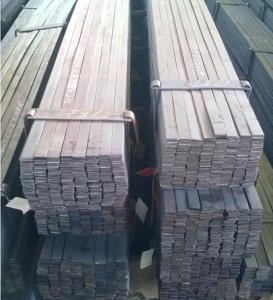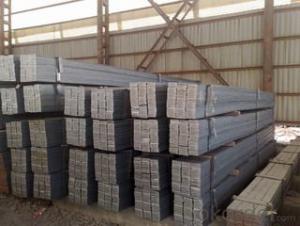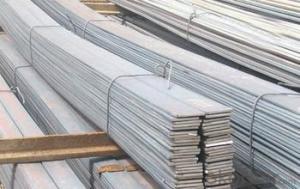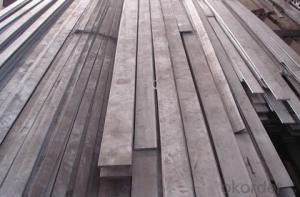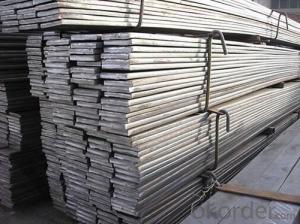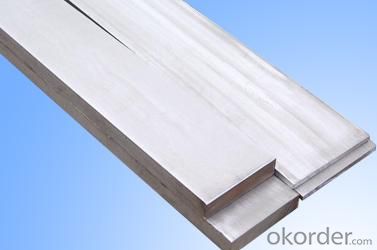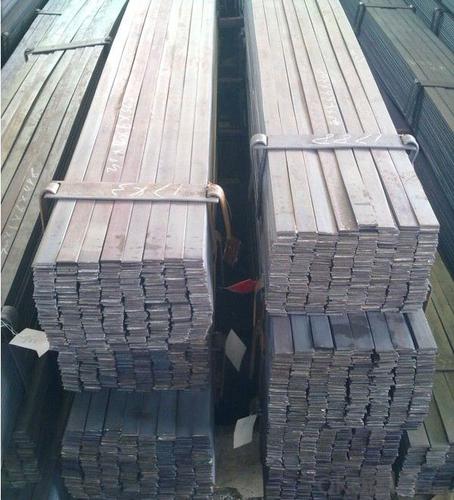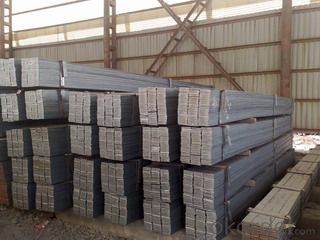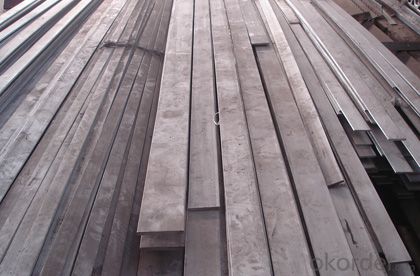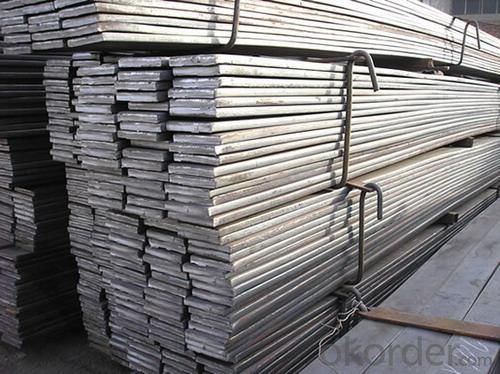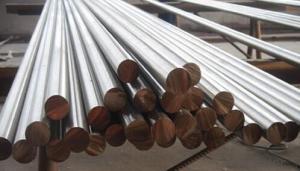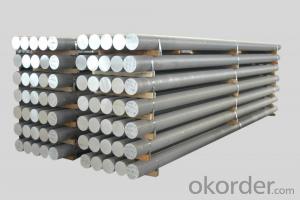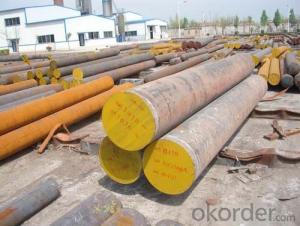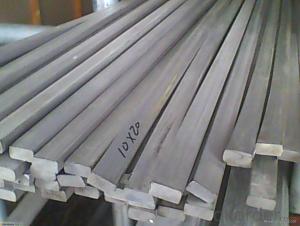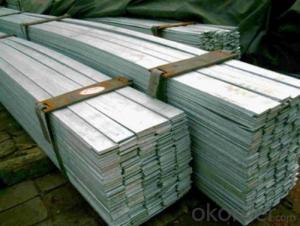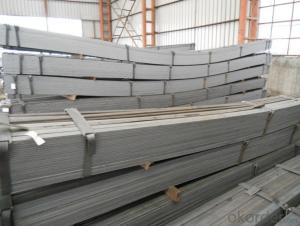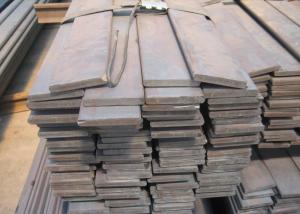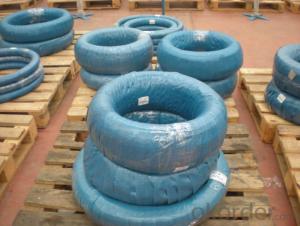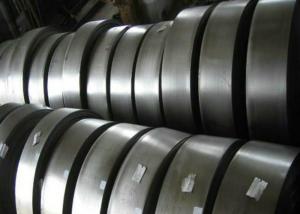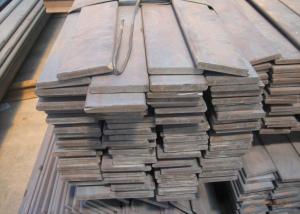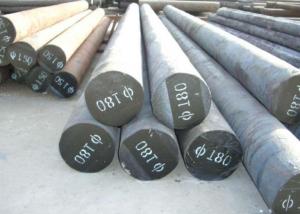Hot Rolled Grade ASTM A36 S235JR SS400 Steel Flat Bar Sizes
- Loading Port:
- Tianjin
- Payment Terms:
- TT or LC
- Min Order Qty:
- 3 m.t.
- Supply Capability:
- 10000 m.t./month
OKorder Service Pledge
OKorder Financial Service
You Might Also Like
Specification
Hot Rolled Grade ASTM A36_S235JR_SS400 Steel Flat Bar Sizes
Details of Hot Rolled Grade ASTM A36_S235JR_SS400 Steel Flat Bar Sizes
Name | Hot Rolled Grade ASTM A36_S235JR_SS400 Steel Flat Bar Sizes |
Shape | Flat Bar |
Standard | GB/ASTM/SAE/AISI/DIN/JIS/EN/BS |
Surface Treatment: | Black/Peeling/Polished/Machined |
Delivery Condition: | Hot Rolled or Forged/Peeled or Black Surface |
Test | SGS/UT 100% Elements Testing |
Certificate: | ISO/Mill Certificate |
Service: | 24 hours online service / |
more than 20 years trading and manufacture | |
Quality Assurance: | the third party inspection, such as SGS, BV, TUV…etc. is acceptable |
Packaging Details: | Seaworthy Packaging or as per customer's packing instruction |
steel flat bar grade | A36, Q235, Q195, SS400, St37-2 |
steel flat bar standard | GB, ASTM, AISI, EN, JIS |
steel flat bar thickness | 1.8mm-17.75mm |
steel flat bar width | 10mm-870mm |
steel flat bar length | 6m, 9m, 12m or as customer requirement |
steel flat bar technique | Slitting hot rolled steel coil |
Specification of Hot Rolled Grade ASTM A36_S235JR_SS400 Steel Flat Bar Sizes
Width | Thickness | Length | Theoretical Weight |
(mm) | (mm) | (m) | (kg/m) |
20 | 2 | 6/9/12 | 0.31 |
20 | 2.5 | 6/9/12 | 0.39 |
20 | 2.75 | 6/9/12 | 0.43 |
25 | 2.5 | 6/9/12 | 0.49 |
25 | 3.75 | 6/9/12 | 0.74 |
30 | 2.5 | 6/9/12 | 0.59 |
30 | 3.5 | 6/9/12 | 0.82 |
30 | 9.75 | 6/9/12 | 2.3 |
40 | 3.5 | 6/9/12 | 1.1 |
40 | 4.75 | 6/9/12 | 1.5 |
40 | 11.75 | 6/9/12 | 3.69 |
50 | 2.75 | 6/9/12 | 1.08 |
50 | 4.5 | 6/9/12 | 1.77 |
50 | 9.75 | 6/9/12 | 3.83 |
60 | 5.5 | 6/9/12 | 2.6 |
60 | 7.5 | 6/9/12 | 3.53 |
60 | 11.5 | 6/9/12 | 5.42 |
80 | 5.5 | 6/9/12 | 3.45 |
80 | 7.5 | 6/9/12 | 4.71 |
80 | 11.75 | 6/9/12 | 7.38 |
100 | 3.25 | 6/9/12 | 2.55 |
100 | 4.75 | 6/9/12 | 3.73 |
100 | 7.5 | 6/9/12 | 5.89 |
120 | 9.75 | 6/9/12 | 9.18 |
120 | 11.75 | 6/9/12 | 11.07 |
150 | 9.75 | 6/9/12 | 11.48 |
150 | 11.5 | 6/9/12 | 13.54 |
150 | 13.5 | 6/9/12 | 15.9 |
160 | 11.75 | 6/9/12 | 14.76 |
200 | 9.5 | 6/9/12 | 14.92 |
250 | 5.75 | 6/9/12 | 11.28 |
340 | 7.75 | 6/9/12 | 20.68 |
CNBM Introduction of Hot Rolled Grade ASTM A36_S235JR_SS400 Steel Flat Bar Sizes Supplier
CNBM International Corporation is the most import and export platform of CNBM group(China National Building Material Group Corporation) ,which is a state-owned enterprise, ranked in 270th of Fortune Global 500 in 2015.
With its advantages, CNBM International are mainly concentrate on Cement, Glass, Iron and Steel, Ceramics industries and devotes herself for supplying high quality series of refractories as well as technical consultancies and logistics solution.

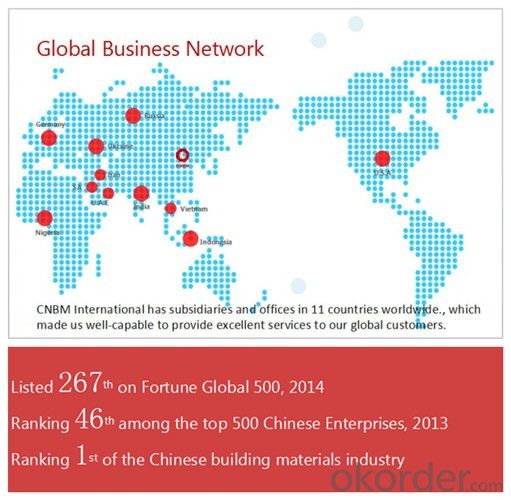
Packaging & Delivery Hot Rolled Grade ASTM A36_S235JR_SS400 Steel Flat Bar Sizes
Packaging Detail | Sea worthy packing /as per customer's packing instruction |
Delivery Detail | 15 ~ 40 days after receiving the deposit |
Products Show
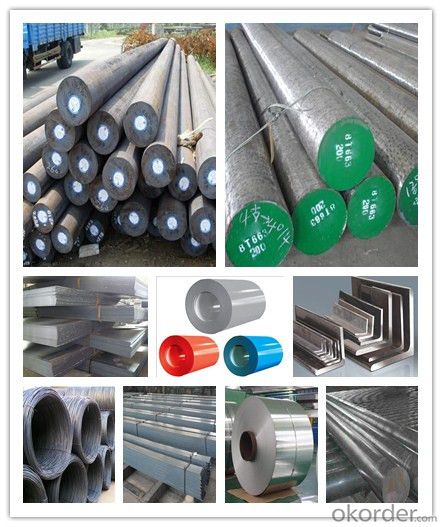
FAQ:
Are you a trading company or manufacturer? | Manufacturer |
What’s the MOQ? | 3 metric ton |
What’s your delivery time? | 15-35 days after downpayment received |
Do you Accept OEM service? | Yes |
what’s your delivery terms? | FOB/CFR/CIF |
What's the Payment Terms? | 30% as deposit,70% before shipment by T/T |
Western Union acceptable for small amount. | |
L/C acceptable for large amount. | |
Scrow ,Paybal,Alipay are also ok | |
Why choose us? | Chose happens because of quality, then price, We can give you both. Additionally, we can also offer professional products inquiry, products knowledge train (for agents), smooth goods delivery, excellent customer solution proposals. |
What's your available port of Shipment? | Main Port, China |
What’s your featured services? | Our service formula: good quality+ good price+ good service=customer's trust
|
Where are your Market? | Covering more than 160 countries in the world |
- Q: What are the main applications of special steel in the defense aircraft?
- Special steels are used in defense aircraft for various critical applications such as manufacturing aircraft components, structures, and armor. These steels possess exceptional strength, durability, and resistance to corrosion and heat, making them suitable for challenging environments. Special steels find applications in components like landing gears, engine parts, rotor blades, and missile systems, where their high performance and reliability are essential for ensuring the safety and effectiveness of defense aircraft.
- Q: How does special steel perform in oil and gas applications?
- Special steel is highly desirable and widely used in oil and gas applications due to its exceptional performance and superior properties. Special steel exhibits excellent resistance to corrosion, which is crucial in environments where oil and gas are present. This resistance to corrosion helps prevent equipment failure and ensures the longevity and reliability of the components. Moreover, special steel possesses high strength and durability, making it suitable for withstanding extreme conditions, such as high pressure and temperature. This strength allows the steel to withstand the demanding and harsh environments that oil and gas applications often present. Additionally, special steel can retain its mechanical properties even at elevated temperatures, providing stability and reliability in these challenging conditions. Another significant advantage of special steel is its excellent weldability. This property allows for easy fabrication and assembly of components, reducing production time and costs. It also ensures the integrity of the structures and equipment used in oil and gas applications. Furthermore, special steel offers exceptional resistance to fatigue and wear, which are common concerns in oil and gas operations. The ability of special steel to withstand cyclic loading and abrasive conditions ensures the longevity and reliability of the components, reducing maintenance and replacement costs. Overall, special steel performs exceptionally well in oil and gas applications due to its corrosion resistance, high strength, durability, weldability, and resistance to fatigue and wear. Its superior properties make it a preferred choice for critical components, ensuring the efficiency, safety, and reliability of oil and gas operations.
- Q: Is special steel suitable for manufacturing precision components?
- Yes, special steel is indeed suitable for manufacturing precision components. Special steel possesses unique properties such as high strength, wear resistance, and excellent dimensional stability, making it ideal for producing components with precise and intricate designs. Additionally, its superior machinability and ability to withstand extreme conditions further enhance its suitability for manufacturing precision components.
- Q: What are the different heat treatment processes for special steel?
- There are several different heat treatment processes for special steel, including annealing, quenching, tempering, case hardening, and precipitation hardening.
- Q: What are the main characteristics of spring steel?
- Spring steel is a type of high-carbon steel that is specifically designed to possess excellent elasticity and resilience. It is primarily known for its ability to return to its original shape after being bent or deformed, making it ideal for applications where repeated and controlled deflection is required. The main characteristics of spring steel include: 1. High Yield Strength: Spring steel is characterized by its high yield strength, which refers to the amount of stress it can withstand before permanent deformation occurs. This allows it to bear heavy loads and resist bending or breaking under pressure. 2. Excellent Elasticity: One of the most significant characteristics of spring steel is its exceptional elasticity. It can be flexed, twisted, or stretched without permanently deforming, and once the force is released, it returns to its original shape. This property is crucial for applications requiring constant and repetitive motion. 3. Superior Fatigue Resistance: Spring steel is exceptionally resistant to fatigue, meaning it can endure millions of cycles of stress without failing. This characteristic is crucial for products subjected to continuous and repetitive loads, such as springs in automotive suspensions or industrial machinery. 4. Good Hardness and Wear Resistance: Spring steel is typically hardened to enhance its wear resistance. This allows it to withstand abrasion and deformation under harsh conditions, making it suitable for applications that involve friction or impact, such as cutting tools or automotive components. 5. Excellent Formability: Spring steel can be easily formed into various shapes and sizes, making it highly versatile for different applications. It can be cold-drawn, rolled, or heat-treated to achieve specific mechanical properties, allowing manufacturers to customize its characteristics based on their specific requirements. Overall, the main characteristics of spring steel are its high yield strength, excellent elasticity, superior fatigue resistance, good hardness and wear resistance, and exceptional formability. These qualities make it a vital material in a wide range of industries, including automotive, aerospace, construction, and manufacturing.
- Q: What are the applications of special steel in the electronics industry?
- Special steel has various applications in the electronics industry. It is commonly used to manufacture components such as connectors, springs, and contacts due to its high strength, corrosion resistance, and electrical conductivity. Additionally, special steel is employed in the production of magnetic cores for transformers and inductors, as it exhibits excellent magnetic properties. Its ability to withstand extreme temperatures and provide reliable performance makes it a preferred choice for electronics applications where durability and efficiency are crucial.
- Q: How does maraging steel achieve high strength through aging?
- Maraging steel achieves high strength through aging by a process called precipitation hardening. After the steel is initially heat-treated to reach a soft and ductile state, it is rapidly cooled to room temperature. During aging, the steel is then heated at a lower temperature to allow for the precipitation of intermetallic compounds. These compounds form within the steel's microstructure, creating a dense network of fine particles that impede dislocation movement, resulting in increased strength and hardness.
- Q: Classification of special steel products
- According to the carbon content of the steel can be divided into low carbon steel (WC = 0.25%), steel (0.25% WC 0.6%) and high carbon steel (wc>0.6%) according to the content of phosphorus and sulfur can be divided into ordinary carbon steel (carbon steel with phosphorus, sulfur, high quality carbon steel (P), low sulfur and high quality (steel) phosphorus, sulfur lower).In general, the higher carbon content in carbon steel, the higher hardness and higher strength, but lower plasticity. This kind of steel is mainly carbon steel to ensure mechanical properties, so the brand reflects its mechanical properties, represented by the Q+ number, "Q" to "yield point bend" word Pinyin prefix, a digital representation of the yield point value, such as Q275 said the yield point is 275MPa. If the grades are marked with letters A, B, C and D, the quality grade of steel is different. The quantity of S and P is reduced, and the quality of steel is improved. If the letter "F" is marked behind the grade, it is "boiling steel". The label "B" is a semi killed steel, and no "F" or "B" is used as a killed steel. For example, Q235-A = F indicates a yield point of 235MPa for grade a rimmed steel, and Q235-c represents a C grade killed steel with a yield point of 235MPa.
- Q: How is mold steel used in the production of plastic injection molds?
- Mold steel is used in the production of plastic injection molds due to its high strength, wear resistance, and ability to withstand high temperatures. It is used to create the core and cavity of the mold, which are crucial components that shape the plastic parts. Mold steel ensures precise and accurate molding, prolongs the mold's lifespan, and enables the production of high-quality plastic products in a cost-effective manner.
- Q: What are the different methods for case hardening special steel?
- There are several methods for case hardening special steel, including carburizing, nitriding, carbonitriding, and induction hardening. Carburizing involves heating the steel in a carbon-rich environment to allow carbon atoms to diffuse into the surface, creating a hardened outer layer. Nitriding, on the other hand, involves introducing nitrogen to the steel's surface, resulting in a hard and wear-resistant layer. Carbonitriding combines both carbon and nitrogen to create a hardened surface with improved wear and corrosion resistance. Lastly, induction hardening utilizes an electromagnetic field to heat and harden specific areas of the steel, providing localized hardness and strength.
Send your message to us
Hot Rolled Grade ASTM A36 S235JR SS400 Steel Flat Bar Sizes
- Loading Port:
- Tianjin
- Payment Terms:
- TT or LC
- Min Order Qty:
- 3 m.t.
- Supply Capability:
- 10000 m.t./month
OKorder Service Pledge
OKorder Financial Service
Similar products
Hot products
Hot Searches
Related keywords

